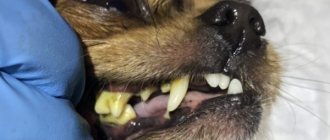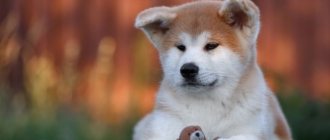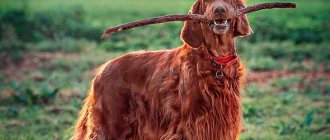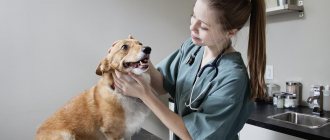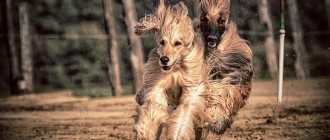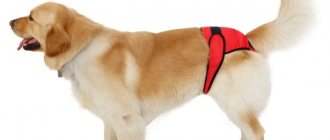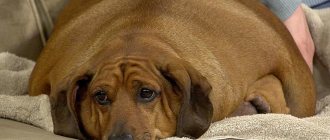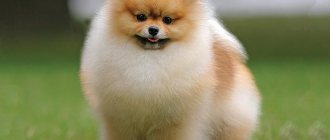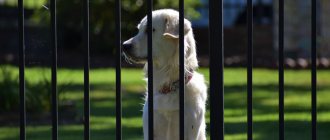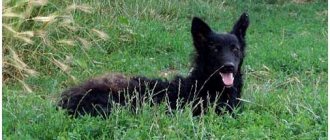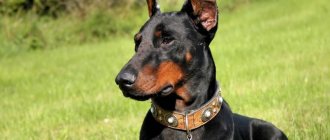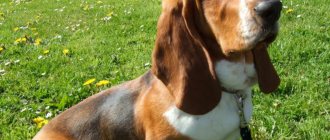There are about 400 dog breeds recognized by various institutes and international clubs. What makes them different? Size, head or ear shape and coat type are some of the key features. When it comes to coats, some races only have one color, while others have spots, stains, or other brands.
HowMeow.ru is here to help you discover the 17 best dogs . Most dogs have fur patterns that combine more than one color. Our list includes dogs with patches of varying sizes that appear against a dominant fur color, as well as dogs with spotted fur.
Pyrenean Mastiff
This gentle giant dog is native to the Aragonese Pyrenees in Spain, where it is used to protect livestock. It has a compact, muscular and slightly rough body, although it is surprisingly agile. The Pyrenean Mastiff has thick, heavy fur that provides ideal protection from the cold. This is a white dog with comedones or beige spots on the face, sides, back or base of the tail.
White Swiss Shepherd
The White Swiss Shepherd is a very muscular and strong dog. Its shiny white coat is one of the main characteristics of the breed. This dog is great for living in cool climates. White Shepherds are known for their good behavior towards children. They are very kind and are considered good protectors, although their large body size can put children at risk. ( Important: Children should always be supervised by an adult when interacting with a dog.)
These large shepherds have a calm nature, but are suspicious of strangers. They will always prefer their family to strangers. It is vital to socialize these dogs well so that they can differentiate between a family friend and an intruder.
Brittany
This is an energetic, medium-sized dog native to the Brittany region of northwestern France. It has a strong and proportionate body with a round head with drooping rectangular ears. Britney has a short and straight coat. Its coat is usually white with black, liver or orange spots.
Description and features
Unlike other Dogos, the Argentinean's height is not so great - from 64 to 68 cm at the withers. The last figure is the height of males. And the weight does not seem impressive - 40-45 kg. But this does not prevent you from experiencing a slight trembling when you first look at the dog. The powerful jaws and menacing expression of the muzzle give them a terrifying appearance.
Dogo Argentinos are brave, even fearless, and very hardy. They were bred as fighting and hunting dogs, mainly for hunting pumas and peccaries (wild pigs). Both are considered dangerous rivals.
The dogs were trained for a long and grueling pursuit of prey, and at the end they still had the strength to fight them. The Dogo Argentino breed is distinguished by a unique bite; they have a square dental arch, which increases the gripping area.
The body looks like it is cast from metal, the muscles stand out in relief under the skin. I would like to say about such a creature - he is built like an athlete. In addition, a massive head with strong jaws, straight posture, a wide torso and straight strong legs. The eyes are small and dark, but one can read intelligence and dignity in them.
Dogo Argentino - built like an athlete
The Dogo Argentino in the photo, even in a calm state, looks like a formidable weapon. But appearances are deceiving. A kind and faithful heart beats in his muscular chest. Therefore, his disposition is not aggressive, but rather cheerful and friendly.
This breed can be called universal. By purpose he is a hunter, and in addition - a security guard, watchman, rescuer, search engine, official, policeman, sports dog, fighting dog, and also a devoted and reliable friend.
Bracco Italiano
The Italian bracco is an excellent spotted dog suitable for hunting. In fact, it was bred for this purpose by hunting in the Middle Ages. His body is thin, with balanced proportions. It has thin but muscular legs, ideal for chasing prey, and its ears are long and thin. It has a short and dense coat, usually white with orange or brown spots. Some people also have jackets.
Nutrition
It is necessary to feed your pet high in calories; nutrition must be balanced since childhood. Babies have a good appetite, so you need to make sure that your pet does not gain weight. Don't be fooled by whining and squealing, he's just twisting ropes out of you. In general, the amount of food consumed should be 7% of the puppy's weight.
As you grow older, you need to switch from four meals a day to two meals a day. Food should be saturated with all necessary microelements, minerals, and vitamins. The choice of type of food is up to the owner. In America, owners more often use meat, while in Europe they give preference to factory-made feed.
It is strictly forbidden to mix both options. Ready-made foods are already well balanced, but note the presence of grains and vegetables in them. It is preferable to avoid chicken meat as a possible allergen. Natural food is based on offal, lean meat, and low-fat dairy products.
You can offer boiled fish without bones, a couple of eggs a week. And be sure to include vegetables and fruits in your menu in accordance with the season. To prevent tartar, it would be good to add tomatoes and solid foods to your diet. No sweets, smoked foods, salty foods or fatty delicacies. Monitor how much your pet eats at one time in order to adjust feeding in the future.
State Reuters Valencia
The Gos Reiter Valencià (sometimes known as the Valencian Rutter) is a small spotted dog that was developed to control rat populations. It is native to Valencia, Spain, where its existence has been documented since the 16th century. This is a muscular and slender breed. It has raised triangular ears and an elongated muzzle. He has short white hair with black or brown spots on the sides and head.
Varieties of face masks
Different breeds of four-legged animals differ not only in the color of their coat, but also in other features of their exterior. Thus, on the dogs’ faces you can see masks characteristic of the breeds.
They are dark - brown or gray. Masks may vary in size and extend to the chest. The marking is combined with a variety of bases: zoned, saddle, tan and brindle. And among greyhounds the mask is called “mazurina”.
Reverse masks are light areas on the dog's face. May be called domino or grizzly. The reverse mask is combined with zonal and saddle tones.
Parson Russell Terrier
This terrier breed originates from Birmingham, in the United Kingdom, where it was developed in 1863. It is a small spotted dog with firm legs and a high tail. It has a short muzzle and small ears that droop slightly forward. The Parson Russell Terrier's coat is short and fluffy. It is predominantly white with black or brown patches around the eyes and ears.
Ratonero bodeguero andaluz
Ratonero bodeguero andaluz (sometimes called Spanish Jack Russell) is a native breed of sherry and sadiz in Spain. It was developed to kill rats and mice in wineries, but currently serves as a companion dog. This is a medium and thin dog with a thin tail. It has short, thin and white fur with brown or black spots on its neck and head. Some people are spotted dogs , with small spots all over the body in addition to the characteristic markings on the face.
Two-color varieties
The combination of two different shades on the body of a four-legged friend allowed breeders and zoologists to talk about a large number of variations. These include quite common types, and those combinations that are difficult to find on an ordinary dog.
Tan
The main tone of this option is gray, brown or dark. The tan color of dogs is distinguished by light spots that sharply border on the main tone. Tan is located on the eyebrows in the form of two spots, on the cheekbones, throat and chest area. There are lightened areas on the muzzle, but in this case the bridge of the nose has the main pigmentation. Tan marks can be seen on the front of the animal's paws, around the anus, and on the bottom of the tail.
Zonar, or wolf
The zonal or wolf version of the two-color color has a light background. At the same time, in certain areas of the animal’s body, yellow, black and lightened areas are clearly visible.
Cheprachny
The basis of a dog’s saddle fur is a red pigment, which gives the pet’s fur coat different shades - from bright red to light fawn. In addition, black or gray becomes the main tone.
The sable color of dogs differs in size and tone. Most often, darker areas are located on the upper part of the animal’s body: on the head, shoulders, back, tail. Lighter pigmentation occurs on the lower jaw, cheeks, throat, chest, and belly.
Sable
The coat of pets with the sable color variant is characterized by a predominance of a reddish tint of varying degrees of saturation. The ends of the hair of such representatives contain a special pigment that colors them black.
brindle
The brindle color in dogs appears as transverse dark stripes on brown or sandy fur. The body of the animals is painted in warm shades: yellow, red, red. There may be gray fur, but it is very rare.
Sometimes the presence of whitish points is noticeable, which is not considered a flaw. The stripes on the dog's body look like rings that break on the stomach. A dark, almost black mask is often visible on the face of a tiger pet.
Murugiya
This option takes as a basis a dark red shade, which varies, reaching the darkest color of mahogany. The ends of the pet's hair are covered in a dark, almost black tone. The nut color, which is called fawn, is also found here. It can range from light sandy to dark golden in tone. Redness is not typical for this species.
English greyhound
The English Greyhound is another popular large spotted dog native to Britain. In ancient times it was used as a hunting dog. He has a strong and aerodynamic body with long and elegant legs. The Greyhound's coat is short and can vary in color. However, the most common are white dogs with spots in various tones, in addition to some spotted areas.
Grooming and hygiene
If a Great Dane has appeared in the family, it is simply necessary to learn all the intricacies of caring for the dog. First of all, to maintain hygiene you need a rubberized mitten (or a medium-hard brush) and a flannel cloth.
It is enough to wipe the dog with a mitten once or twice a week. This removes dead skin particles and loose hairs, and also improves blood flow. The dog is wiped with a flannel cloth to add shine to the coat.
Special cosmetics also help to maintain a neat appearance for your pet.
Using shampoos
The first and main rule: when caring for the coat of a Great Dane, do not use human shampoo! This applies to all four-legged pets. The fact is that there are no sweat glands on the body of dogs; sweating occurs through the tongue. Therefore, the acid balance of humans and dogs does not match.
For Great Danes - only special care products! Experts recommend dry shampoos.
The dog should not be washed with hot water. Smooth coat without undercoat makes the skin more sensitive. Water temperatures up to 40°C are sufficient. The bottom of the bathtub should be covered with a mat or towel during bathing to prevent the dog's paws from slipping. During the procedure, you need to cover your pet’s eyes, praise him, and encourage him.
Shampoo with lanolin works well to add shine to the coat of a Great Dane. This component does not harm the pet and maintains the natural beauty of a healthy coat. Too concentrated shampoo is harmful - it is better to dilute it with water. You need to rinse off the product very carefully - your pet can lick off the residue.
The Great Dane does not need to be blow-dried or towel-dried. The dog will dry itself, the main thing is not to let it out into the draft.
Now about oral hygiene. The dog's mouth is wiped every time after eating. You can buy a special sponge, but a dish sponge with the hard part cut off will also work. The Great Dane needs to have its nails trimmed or filed, and its ears cleaned once a month.
Important! Of all the grooming procedures, the dog least tolerates cleaning the ears, teeth and removing claws with a special nail clipper. To avoid problems, it is necessary to accustom your dog to such hygiene from childhood. An animal will tolerate bathing and cleaning much easier if you praise and encourage it.
One of the common problems of this breed is a violation of the integrity of the skin on the pads of the toes. It is necessary to regularly inspect them to ensure that there are no cracks or wounds. For prevention, you can rub sunflower oil into your dog’s paws.
It is enough to examine your pet’s ears 1-2 times a week. If your dog rubs the floor, tries to scratch his ear with his paw, or jerks his head, consult your veterinarian.
Shedding
Oddly enough, Great Danes during molting cause a lot of trouble for the owner. Short prickly “needles” will be scattered throughout the apartment. To avoid such surprises, during shedding your pet is cleaned with a rubberized mitten more often, ideally every day.
Even if the dog is far from the show ideal, he will become a wonderful companion for the whole family. Dogs of this breed are unusually smart: they are loyal friends to their own, and a thief or a bully can only be pinned down by the Great Dane with its massive, strong paw.
Coat color is an important factor influencing the appearance of a dog. Representatives of dog breeds that allow different colors are sometimes so different from each other due to color that people mistake them for completely different breeds. Our text today is dedicated to black and white dogs: we will tell you in which breeds this spectacular contrasting color can be found, talk about the characters of these dogs, the peculiarities of their maintenance, and briefly discuss their psychological and physiological qualities.
Black and white dog - what breed are you?
German shorthaired pointer
Originally bred as a hunting dog, the German Shorthaired Pointer is an energetic breed known for its noble appearance. He is large and muscular, with an elongated head and drooping ears. Individuals come in a variety of colors and shades, but the most common is white with black or brown spots on the chest and legs, in addition to large spots on the flanks.
Long-haired dog breeds
Afghan Hound
The Afghan Hound has much in common with the Saluki; the breed originated in Afghanistan and was used for guarding and service. The average weight of a pet is 35 kg. The breed is distinguished by its long coat of cream, beige with black markings. By nature, they are patient, obedient, devoted and savvy animals who love children.
Read: Super premium food.
Bobtail
The bobtail first appeared in England, the name translates as “Old English Sheepdog.” Previously, the breed was used for grazing livestock, now as a companion. The size of the bobtail is large, the coat is long, thick with curls. The main shade is gray with blue, marble, blue with black. The character is characterized by kindness, sociability and attentiveness. The peculiarity of the animal is its loud bark.
Yorkshire Terrier
The Yorkshire Terrier dog is a small, decorative dog that originated in England and is considered one of the most popular pets in the world. The animal's coat is long, silky, and becomes lighter with age. The main color is golden, bronze, cream, often several shades at once. The terrier is distinguished by fearlessness, courage, activity, and playfulness.
Collie
Collie (Scottish Sheepdog) is a medium breed of dog, bred for herding livestock in England and Scotland. Now the pet is used for canine competitions or as a companion. Average size - 25 kg, has muscular paws. The coat is long, sometimes rough. The main colors are black, red, tan, sable. The animal's temperament includes endurance, intelligence, activity, and sociability.
English cocker spaniel
The Cocker Spaniel was bred in England for hunting and later became a friend and companion for many owners. The dog has a medium build, weighing up to 15 kg. The coat is long, silky, the main color is red, black, tan and black with blue. The dog's character is characterized by mobility, energy, peacefulness, and attentiveness to the owner's mood.
It is important that your cocker spaniel gets plenty of walks, active play, and training. It is better to keep it in a country house to satisfy the hunting instinct.
Maltese (Maltese)
The Maltese is a small breed that first appeared in Malta. The main feature is long, thick wool of a snow-white shade. Average weight – 3 kg. The main highlight of the breed is its tenderness and sensitivity, intelligence. The dog is also characterized by mobility, savvy, courage, and loyalty to the owner. As a child, the Maltese bites and snaps, so it requires training.
Newfoundland
The Newfoundland dog was bred in Canada for work and hunting. The main feature of the breed is its long, thick coat of black, black-white or brown shade. Belongs to the Molosser breed, the maximum weight of the pet is 67 kg. By temperament, they are calm, balanced, intelligent and flexible animals. It is better to keep it in a country house, as it requires a lot of space for walking, is easy to train and makes decisions on its own.
Pomeranian Spitz
The Pomeranian Spitz is a decorative breed that originated in Germany, the province of Pomerania. The main feature of the dog is its long, soft and fluffy fur, as well as a small fox-like muzzle. Wool comes in ten shades, but the most popular are black, black and tan, cream, red, and blue and tan. Despite its small size, the dog is fearless, playful, active, and loves children.
Remember that the Pomeranian Spitz is characterized by aggressiveness and jealousy, so the pet needs to be given a lot of time, raised and trained.
Pekingese
The Chinese Pekingese is a small breed of apartment dog that originated several thousand years ago in China. It is interesting that the Chinese themselves call dogs “fu” and consider them protective spirits. The coat comes in several shades, but black and red Pekingese are more common. The weight of the animal does not exceed 5 kg. By nature, they are playful, spoiled, independent pets.
Saint Bernard
The long-haired Saint Bernard originated in Switzerland and Italy and is believed to be a descendant of Tibetan mastiffs, which were used to climb the Alps. The dog has a large body, thick coat of white or red color with spots. The main feature of the St. Bernard's character is loyalty and obedience; they are also characterized by attentiveness and love for family.
Tibetan mastiff
The Tibetan Mastiff is considered one of the oldest breeds that originated in Tibet and previously lived in monasteries. Externally, it is a large pet, weighing up to 75 kg. The mastiff's coat is thick, with an undercoat of gray, dark, beige shades with spots. Despite its size, the pet is distinguished by calmness, obedience, loyalty, and adequacy. They can be guards, defenders, and used for hunting.
Chow chow
The name “Chow Chow” is translated as shaggy lion, which fully corresponds to the appearance of the dog. They first appeared in Korea; the breed belongs to the Spitz group. Can be used for home security or as a companion. The coat of the Chow Chow is long, fluffy and thick, the main color is black, blue, red, cream. The average weight of the animal is 27 kg. By temperament, the dog is characterized by caution towards strangers, love and loyalty to the owner, and laziness.
It is important to go for walks with your chow chow as often as possible and do some training. Because the pet prefers to lie on the sofa than to run and play, which is why it often suffers from obesity or a bad mood.
Shih Tzu
The Shih Tzu is considered one of the most ancient breeds; it first appeared in China as a gift to the emperor. A small Shih Tzu dog with long hair of different shades, but the most common colors are black, red, brown and white-red. The maximum weight of a pet is no more than 8 kg. By nature, they are active animals, require a lot of attention, are attentive to the mood of others, love children and are devoted until the end of their lives.
South Russian Shepherd
The South Russian Shepherd Dog was bred in Russia to herd cattle several hundred years ago. In size - a large dog with long hair of white, fawn, gray-piebald shades, average weight - 25 kg. A shepherd dog can be used for protection, security, service and as a pet. The shepherd's character is characterized by savvy, independence, loyalty, and anger towards strangers. Therefore, you need to start raising a dog from childhood.
English pointer
It is a medium-sized dog first developed in Britain in the 17th century. They are a slender race known for their intelligence and curiosity. The English Pointer has a smooth and very short coat. It is usually white with brown, reddish or liver spots distributed on the head and flanks. The fur on its legs is often dyed.
Training the Dogo Argentino breed
Not for novice trainers, the Dogo Argentino has a tendency to display dominance and is often stubborn.
The Dogo Argentino will constantly question authority and will only obey commands from those he respects. His coach absolutely needs to be in control at all times, showing consistency and firmness.
Jack Russell Terrier
The Jack Russell Terrier is another small spotted dog of the terrier family. Originally bred for fox hunting in the United Kingdom, it has an elongated body and short legs. An energetic dog, he loves games and outdoor activities. This breed has a short and smooth coat. Usually white with black spots or reddish spots on the flanks and head.
Dalmatian
After reading this far, you have to ask yourself about the spotted dog breed that is more famous than all the others: the Dalmatian. Thanks to Disney's 101 Dalmatians, the Dalmatian is the most popular spotted dog in the world, an active and affectionate dog first bred in Croatia in the 17th century. It has a well-proportioned, rectangular body and characteristically drooping ears. It has a short, soft white coat, usually spotted with black, although some people have brown spots.
Norrbottenspets
Norrbottenspets are a breed from Sweden, where they were used as a hunting dog in the past. This is a small spotted dog with a compact and proportional body. Characterized by its raised and pointed ears. norrbottenspets have a smooth, semi-long coat. It is usually white with reddish spots on the back, sides and head.
The rarest types and tones of dog colors
There are rare color variants that are found only in some breeds. For example, Blenheim combines the mottled hue of rich chestnut with a pearly white background. This type of coat is typical for Cavalier King Charles Spaniels. This breed has a white diamond-shaped pattern on the crown of their head.
Pit bulls, bull terriers, corgis, Aussies and other breeds have a rare type of color called merle. This is uneven pigmentation of the coat. Merle appears as a combination of the same dark or light background.
Merle is rare, since the gene responsible for this coloring carries deviations in health. It is prohibited for breeding in most breeds.
Bull Arab
The Arabian bull is a spotted dog from Australia, where it developed as a hunting dog. Like other bull breeds, it is characterized by a strong but agile body. He is known for his intelligence and physical stamina. The bull arab's coat is short and appears in a variety of colors. The most common is white with reddish spots throughout the body.
Price and owner reviews
Nowadays, buying a Dogo Argentino will not be a problem; it has firmly established itself in both Europe and Russia. There are special nurseries that specialize in breeding such dogs, and not only in high-status cities, but also in the periphery.
You can get a healthy pet from a trusted breeder who will provide you with a passport, vaccination certificates and compliance with the breed standard. It is best to take a baby from 1.5 months. When choosing, look at the conditions of detention and the appearance of the future pet.
General rules – the coat is smooth, the eyes are clear and clean, the nose is moist. Throw your keys or a coin on the floor to test your hearing. The cost of a middle class Argentinean baby is approximately 500-800 dollars. The price of a show-class Dogo Argentino is slightly more expensive ($1000 or more).
The breed is becoming increasingly popular for its fit appearance, discreet character, numerous talents, mental strength and virtual absence of diseases. He is noble, courageous, cheerful and has an innate sense of self-worth. The standard of canine devotion and fidelity.
But reviews about them on the Internet are very different. During the discussion, people share problems in the content, but usually they can be solved. For example, too much appetite, excessive salivation, dental problems due to lack of calcium. More often there are rave reviews - “as affectionate as a cat”, very understanding, a dog-psychologist, not scary with him.
The Dogo Argentino is the standard of master's loyalty and devotion.
When describing it, some people will certainly hear the phrase “killing machine” or “monster dog”, but you need to look carefully at who is writing it. Experienced dog breeders or serious breeders will never reward a dog with qualities acquired from people. She is credited with cruelty for which man is responsible.
However, a poorly trained Dogo Argentino can be very dangerous. It’s not for nothing that they are called “white angels of death” in their homeland. The ruthlessness and bloodthirstiness of the ancestors lies dormant in the genes.
Therefore, the most important and necessary point is proper education. It is best to contact a specialist for this. Otherwise, you may not only lose your dog, but also have more severe consequences.
Tenterfield Terrier
This spotted terrier is also from Australia, where it was first raised in the 19th century. This is a small dog with a thin body and long legs. He has a strong personality and requires proper socialization. The Tenterfield Terrier's coat is short and smooth. Typically a white dog with black, tan or liver spots on the flanks and head.
Bolognese
The Bolognese is a curly little dog with round dark eyes that is attractive with a sweet expression and loves to have fun. This is a curious, funny, intelligent and loyal animal. He doesn't need long walks every day, but will do it if necessary. If you are the kind of person who can't say no to an adorable, small, white and fluffy dog, you will have problems with an adult Bolognese as he needs proper training from an early age. The curly coat of these small dogs requires daily brushing and sometimes professional grooming.
The Bolognese is one of several white dog breeds that have been known in the Mediterranean for at least 2,000 years. The breed was popular at the ducal courts in Italy, particularly in Bologna, where it got its name.
Pajon Navarro
The Patchón Navarro is a Spanish dog originally from Navarre. It is a large spotted dog, capable of reaching 30 kg, originally bred for hunting. He has a wide head and drooping ears. Its fur is short and white with reddish or chestnut spots throughout, in addition to larger spots on the face, ears, and back.
Komondor
The Komondor may look like a mop with four legs, but underneath that long coat is a big dog with a huge personality. He is smart, independent and a great defender. His favorite pastime is watching his family. This creates some problems. First, it can be annoying to have a dog sit and stare at you all day long. On the other hand, the Komondor's protective instincts and suspicious nature can lead to trouble (and lawsuits) if your dog attacks someone it perceives as a threat.
Obviously, this dog needs to be properly socialized and raised. The Komondor is capable of being aggressive towards other dogs, but can have excellent relationships with cats and livestock.
Carea leones
The Carea Leones (or Leonese Sheepdog) is another Spanish spotted dog bred for herding sheep. It is medium-sized with a long snout and floppy or straight ears, depending on the individual. It has a strong, muscular body with an upward curved tail. Carea leones has a semi-long and smooth coat. It has white or gray spotted fur with liver or black spots. There are also some completely black examples.
Advantages of smooth-haired dogs
Before choosing a pet, the owner should decide for what purpose he needs the pet.
Regardless of appearance and size, even small dogs of these breeds are capable of guarding a home and, if necessary, protecting a person.
This is interesting: Top 10 best guard breeds
Pets with short hair have many advantages over their long-haired counterparts:
- no constant bathing or special care required;
- the wool looks neat;
- no tangles or lumps;
- no hairdryer required for drying;
- there is no need for long active walks;
- a smooth-haired animal is well suited for allergy sufferers;
- It's easy to clean up after being outside.
English Setter
This breed is native to England and is known for its beautiful appearance. It has a compact and proportionate body with strong legs and a slightly curved tail. Its muzzle is elongated and its ears can be long or short. The English Setter's coat is semi-long in most parts of the body, but in the tail the chest and abdomen grow strongly, almost reaching the ground. It is a white dog with black, reddish or blue spots .
How to buy a Great Dane puppy
Puppies of this breed are purchased at the age of 3-5 months. It is better to purchase a dog from bona fide breeders or a kennel. Before buying a puppy, you need to study reviews about the owners, visit the nursery and watch the animals. It is important in what conditions they are kept and how the mother behaves. The breeder must provide all the necessary documents, a veterinary passport with vaccination marks.
Puppies should be clean, cheerful, with smooth shiny coat. It is recommended to take the most active baby who does not show aggression or cowardice. He should have clean eyes, ears without discharge or unpleasant odor, and a soft belly.
The price of a purebred Great Dane in Moscow is 40-60 thousand rubles. Show class dogs will cost from 65 to 100 thousand. But in one litter there may be puppies with breeding defects, which will not be allowed to show. This usually does not affect the health and character of the pet. Such dogs cost 10-20 thousand rubles. It is impossible to buy a purebred Great Dane at a lower price; it will be a mixed breed.
The photographs show what Great Dane puppies should look like:
Great Dane puppies
Blue and merle Great Dane puppies
Before you decide to get such a large and intelligent dog, you should watch the video:
Video: Great Dane
Video: Great Dane - tender devotion and noble strength
Great Danes are ideal family dogs. They are not angry, sociable, calm. They love children very much and strive to constantly be in the center of attention. This dog should become a member of the family, then he will be a devoted friend and faithful protector. But for this it is necessary to provide him with normal living conditions and sufficient physical activity. Great Danes are strong and powerful dogs, but they need attention and care.
